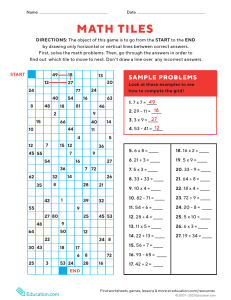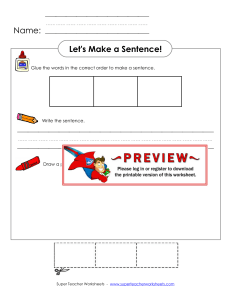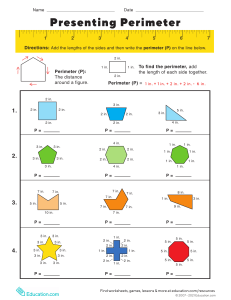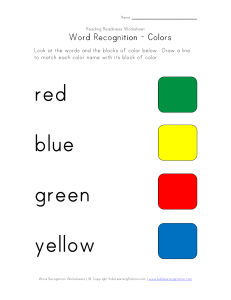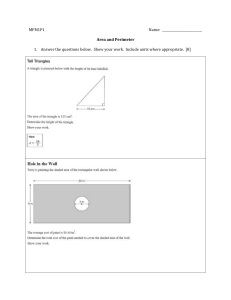usr local src education.com files static lesson-plans el-support-lesson-real-life-perimeter el-support-lesson-real-life-perimeter
advertisement
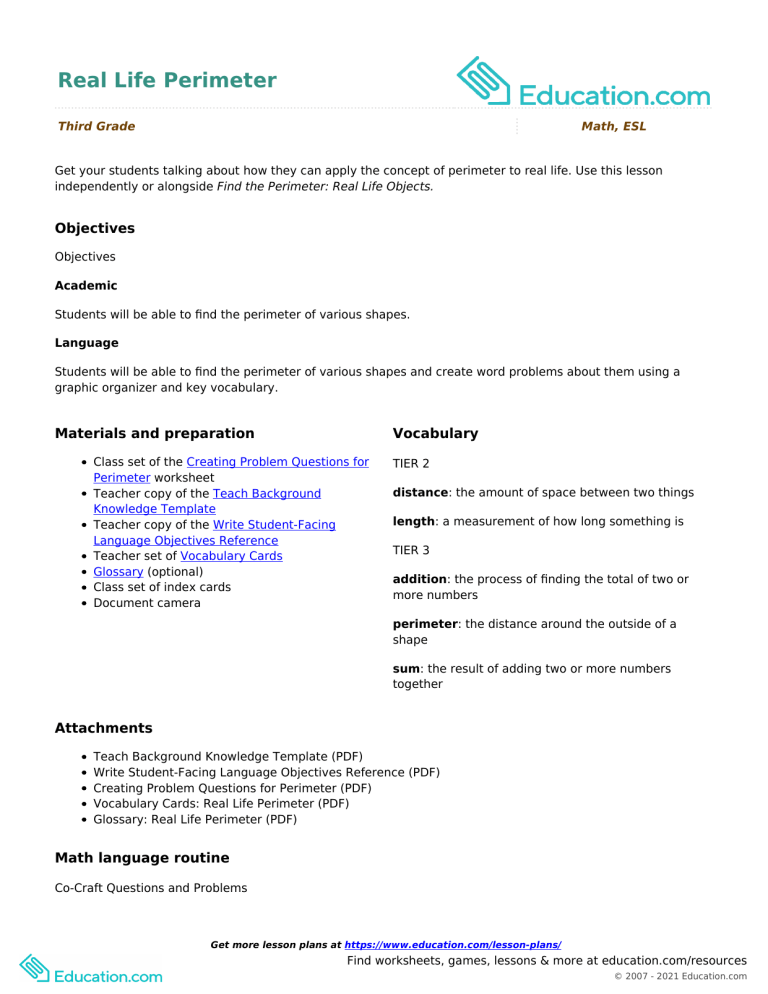
Real Life Perimeter Third Grade Math, ESL Get your students talking about how they can apply the concept of perimeter to real life. Use this lesson independently or alongside Find the Perimeter: Real Life Objects. Objectives Objectives Academic Students will be able to find the perimeter of various shapes. Language Students will be able to find the perimeter of various shapes and create word problems about them using a graphic organizer and key vocabulary. Materials and preparation Vocabulary Class set of the Creating Problem Questions for Perimeter worksheet Teacher copy of the Teach Background Knowledge Template Teacher copy of the Write Student-Facing Language Objectives Reference Teacher set of Vocabulary Cards Glossary (optional) Class set of index cards Document camera TIER 2 distance: the amount of space between two things length: a measurement of how long something is TIER 3 addition: the process of finding the total of two or more numbers perimeter: the distance around the outside of a shape sum: the result of adding two or more numbers together Attachments Teach Background Knowledge Template (PDF) Write Student-Facing Language Objectives Reference (PDF) Creating Problem Questions for Perimeter (PDF) Vocabulary Cards: Real Life Perimeter (PDF) Glossary: Real Life Perimeter (PDF) Math language routine Co-Craft Questions and Problems Get more lesson plans at https://www.education.com/lesson-plans/ Find worksheets, games, lessons & more at education.com/resources © 2007 - 2021 Education.com Introduction (2 minutes) Assess students' prior knowledge about today's key concept by writing the word perimeter on the board inside a circle. Have students share what they know about the concept, record their thoughts, creating a web graphic organizer around the word perimeter. Tell learners that today they will work with perimeter and focus on the process of finding the perimeter of polygons. They'll also focus on what types of questions could be asked about perimeter. In this lesson, they will make real-life connections to the math concept by playing the role of a teacher. Go over the Language Objective and have students repeat it aloud. Explicit Instruction/Teacher modeling (10 minutes) Teach the key terms for the lesson that students will be using as they explain their processes. Use the Vocabulary Cards to display each tiered word on the document camera. Go over the word, definition, and the image on the card. Use this time to define any other words that came up in the lesson's Introduction that your students may need to review. Ask students to turn and talk to a partner about how the words are related. Provide a sentence stem for them to use as they share their thoughts. For example, "These words are related because ____." Explain to learners that the words are related because they all help us explain the process of finding the perimeter of objects. Share that finding the perimeter is something that we do in our everyday lives in many different situations. Give a real-life example of needing to find the perimeter. Say, "When we moved into our new house, we had to get a new fence. We had to find the perimeter of our backyard so that we could share that information with the fence company. To find the perimeter, I measured the length of each side of the yard, and I added all of the lengths together. The sum was the perimeter." Display a copy of the worksheet entitled Creating Problem Questions for Perimeter, but only point out the three-columned graphic organizer. Explain that the mathematical representation is the shape, the question is the word problem, and the answer is the work and the perimeter. Tell the class that you will do this on the board, and then they will use the graphic organizer later. Draw a rectangle on the board, and review the attributes of the shape as needed. (i.e., A rectangle has four sides, two of which are longer than the other two.) Think aloud about a realistic situation and measurements for the rectangle. Say, "This rectangle is a visual representation of a bedroom in my house that got water damage during the storm. I need new floorboards around the whole room because the water ruined them. The length of the long side of the room is 10 feet and the short side is 8 feet. If this long side is 10 feet, then the other long side also has a length of 10 feet. If this short side is 8 feet, the other short side is also 8 feet in length." Label the measurements on the rectangle. Think aloud about a word problem that could accompany this mathematical representation. For example, say, "The big storm caused damage in this room, so the bedroom needs new floorboards. How much wood is needed to fix the border of the bedroom?" Write the word problem on the board to serve as a reference for the students. Underline the question and put a box around the situation. Explain that good word problems have a situation and a question that work together to make the entire problem make sense. Model finding the perimeter by adding 10 + 10 + 8 + 8 = 36 feet. Explain the process, using the Vocabulary Cards as a reference to make sure you use each of the key terms. Share that the answer of 36 feet means that you need 36 feet of wood in order to fix the floorboards. Emphasize that the answer always needs to be connected to the context of the problem. Guided Practice (10 minutes) Distribute a copy of the Creating Problem Questions for Perimeter worksheet to each student. Engage the class in coming up with a word problem for the rectangle on the worksheet. Guide them in conversation about realistic measurements and a realistic situation. Ask prompting questions to get students brainstorming the situation and question: What measurements make sense for this situation? (Measurements that make sense are ____.) If you know the measurement for this side of the shape, how can that help you with the measurement for the other sides? (This measurement helps me because ____.) Do those measurements make sense for this object? (These measurements do/do not make sense because ____.) Get more lesson plans at https://www.education.com/lesson-plans/ Find worksheets, games, lessons & more at education.com/resources © 2007 - 2021 Education.com What story can you tell about this shape? (I think I can tell a story about ____.) How will you find the answer to your problem? (To find the answer ____.) Guide students as they write a situation and question in the center column of the graphic organizer. Then, have them answer the question on their own. Discuss as a class and remind students to use the vocabulary words in their explanations. Put students into partnerships and have them complete the second row on the Creating Problem Questions for Perimeter worksheet. Circulate and pose questions to get students discussing and thinking more deeply. Call on partners to share their work with the rest of the class. Provide feedback and clarification as necessary. Ask peers to share whether they agree or disagree with how the work was done and why. Prompt them to think about if the context for the problem and answer makes sense. Group work time (13 minutes) Instruct students to complete the third and fourth rows on the worksheet. Point out that they have the choice of which shape to use in their word problem, so they should draw it in the Mathematical Representation column. Circulate and support students as they work. Pose questions to get them explaining their thinking and process, and invite struggling students to work in a small, teacher-led group if necessary. Divide the class into small groups and instruct each individual to share one of their word problems with the group. Have them show their shape, read aloud their question, and explain how they found their answer and what the answer means. Have one representative from each small group share with the whole class. Offer praise, feedback, and clarification as needed while the students share. Additional EL adaptations BEGINNING Allow access to reference materials in home language (L1). Have learners repeat instructions and key vocabulary to the teacher. Provide a set of Vocabulary Cards and a Glossary of key terms and phrases for students to use in group and class discussions. Group students intentionally based on academic and language needs. Supply a list of real-life examples in which you can find the perimeter as well as a list of vocabulary to accompany the situation. ADVANCED Allow learners to utilize glossaries and dictionaries for unfamiliar words. Encourage students to answer questions and participate in discussions without referring to the sentence stems or frames for support. Choose advanced ELs to share their ideas first in group and class discussions. Have learners repeat instructions and key vocabulary, summarizing important information for the class. Put students in mixed ability groups so they can offer explanations and provide feedback to beginning ELs when appropriate. Assessment (3 minutes) Give each student an index card and have them write a sentence, phrase, or accompanying visuals using the vocabulary from the lesson. Display the Vocabulary Cards for students to reference during this assignment. Review and closing (2 minutes) Instruct learners to turn and talk to a partner, sharing what they wrote on their index card. Allow them to make changes at this time as they share with and listen to their partners. Remind the class that finding the perimeter is something that we do in real-life, so it is important to know Get more lesson plans at https://www.education.com/lesson-plans/ Find worksheets, games, lessons & more at education.com/resources © 2007 - 2021 Education.com the process. Get more lesson plans at https://www.education.com/lesson-plans/ Find worksheets, games, lessons & more at education.com/resources © 2007 - 2021 Education.com Teach Background Knowledge Lesson Topic: Choose a topic from the main content lesson that will help ELs understand the main content lesson. Your non-ELs will already have knowledge about this topic. Total Lesson Time: (20 - 30 minutes) Student-Facing Language Objective: Example: I can learn new vocabulary using pictures and sentence frames. Student ELP Level(s): Consider each student’s ELP level and their academic strengths when choosing scaffolds for the lesson. Potential Scaffolds: Choose some of these material supports and instructional scaffolds based on each EL’s individual strengths and needs. Groupings (pairs, small-groups, a teacher-led group) Word banks, word wall, and bilingual glossaries Sentence frames, sentence stems, and paragraph frames Home language materials Reduced linguistic load, repetition, rephrasing and modeling Practice new academic skills with familiar topics Materials & Resources List List the materials you’ll use in the lesson. Key Vocabulary Words (5-8 words) List the words with student-friendly definitions in English. Provide definitions in student’s home language when appropriate. Get more lesson plans at https://www.education.com/lesson-plans/ Copyright © 2018 Education.com LLC All Rights Reserved FindFind worksheets, games, lessons & more education.com/resources worksheets, games, lessons & at more at education.com/resources More worksheets at www.education.com/worksheets © 2007© - 2019 2007Education.com - 2021 Education.com Introduction Access EL’s prior knowledge about the lesson topic with a brief comprehension check. Potential activities: Creating captions for images Opinionnaires Carousel brainstorming Conversations with sentence starters Time estimate for Introduction (3 - 5 minutes) Explicit Instruction of Background Knowledge Model a learning activity that embeds the teaching of academic language and background knowledge. Potential activities: Lunch brunch discussion Teacher-created, adjusted text and questions Brief videos or visuals Text-based instruction Home-language connections Pre-teach a small number of vocabulary words Show real-world objects Complete word family or bilingual glossaries Word walls or word bank creation Time Estimate for Explicit Instruction (4 - 6 minutes) Guided Practice Provide an opportunity for students (in pairs or small groups) to practice the skill or information taught during Explicit Instruction, offering appropriate scaffolds as needed. Time Estimate for Guided Practice (5 - 7 minutes) Get more lesson plans at https://www.education.com/lesson-plans/ Copyright © lessons 2018&Education.com LLC Rights Reserved FindFind worksheets, games, lessons more education.com/resources worksheets, games, & at more atAll education.com/resources More worksheets at www.education.com/worksheets © 2007© - 2019 2007Education.com - 2021 Education.com Formative Assessment Ask students to show comprehension of new background knowledge and associated skills through an oral or written task. Provide appropriate scaffolds dependent on their ELP level. Potential assessments: Act out concepts Hands on tasks Drawings, models, or graphs Graphic organizer completion Captions of images Reading response or content area logs Retellings Role plays Audio or video recordings Oral interviews Time estimate for Assessment (5 - 7 minutes) Review and Closing Refer to the student objective and relate information to future lessons. Allow students to share thoughts about whether they reached their objective and/or mention lingering questions. Provide sentence stems or frames for their discussion. Time estimate for Review and Closing (3 - 5 minutes) Get more lesson plans at https://www.education.com/lesson-plans/ Copyright © 2018 Education.com LLC All Rights Reserved FindFind worksheets, games, lessons & more education.com/resources worksheets, games, lessons & at more at education.com/resources More worksheets at www.education.com/worksheets © 2007© - 2019 2007Education.com - 2021 Education.com Write Student-Facing Language Objectives A teacher-facing language objective: A student-facing language objective: begins with “Students will be able to...” is designed to raise students' self-awareness of and promote their language development. incorporates a language function, grammar structure, and supports or scaffolds. is intended to guide the teacher’s lesson planning and instruction. begins with “I can...” is designed to raise students' self-awareness of and promote their language development. incorporates a language function, grammar structure, and supports or scaffolds. is easy to understand for students at all levels of English proficiency. Steps to convert a teacher-facing objective to a student-facing objective: 1. 2. Replace “Students will be able to” with “I can.” Simplify challenging words but maintain key vocabulary words you’ll address in the lesson. Students will be able to describe a character with adjectives using graphic organizers. Language Function Grammar Structure Support/ Scaffold I can talk about a character with adjectives using graphic organizers. Language Function Language Functions locate show sort tell contrast create describe ask questions brainstorm classify identify infer interpret collect compare Grammar Structure Support/ Scaffold Supports/Scaffolds Grammar Structures nouns modals verb forms conjunctions sentence structure pronouns comparatives adverbs academic vocabulary adjectives phrases prepositions complex sentences graphic organizers teacher modeling word banks/walls sentence starters strategic grouping home language supports Get more lesson plans at https://www.education.com/lesson-plans/ Find worksheets, worksheets, games, lessons & All more at education.com/resources Copyright © 2018 Education.com LLC Rights Reserved Find games, lessons & more at education.com/resources More worksheets at www.education.com/worksheets ©-2007 - 2021 Education.com © 2007 2019 Education.com N a me Da te Creating Problem Questions for Perimeter Directions: Look at the shape in the first column. Label the length and width of each shape. Then, write a problem question and find the solution to the question you created. Be sure to show your work! Mathematical Representation Question Answer 1. 2. 3. Draw your own! 4. Draw your own! Get more lesson plans at https://www.education.com/lesson-plans/ Find lessons & more at education.com/resources Find worksheets, worksheets,games, games, lessons & more at education.com/resources © 2007 2019 Education.com ©-2007 - 2021 Education.com addition distance the process of finding the total of two or more numbers the amount of space between two things length perimeter length a measurement of how long something is the distance around the outside of a shape Get more lesson plans at https://www.education.com/lesson-plans/ FindFind worksheets, games, lessons & more education.com/resources worksheets, games, lessons & at more at education.com/resources © 2007© - 2019 2007Education.com - 2021 Education.com sum the result of adding two or more numbers together Get more lesson plans at https://www.education.com/lesson-plans/ FindFind worksheets, games, lessons & more education.com/resources worksheets, games, lessons & at more at education.com/resources © 2007© - 2019 2007Education.com - 2021 Education.com Word Definition addition the process of finding the total of two or more numbers distance the amount of space between two things length a measurement of how long something is Visual length perimeter the distance around the outside of a shape sum the result of adding two or more numbers together Get more lesson plans at https://www.education.com/lesson-plans/ Find lessons & more at education.com/resources Find worksheets, worksheets,games, games, lessons & more at education.com/resources © 2007 2019 Education.com ©-2007 - 2021 Education.com
